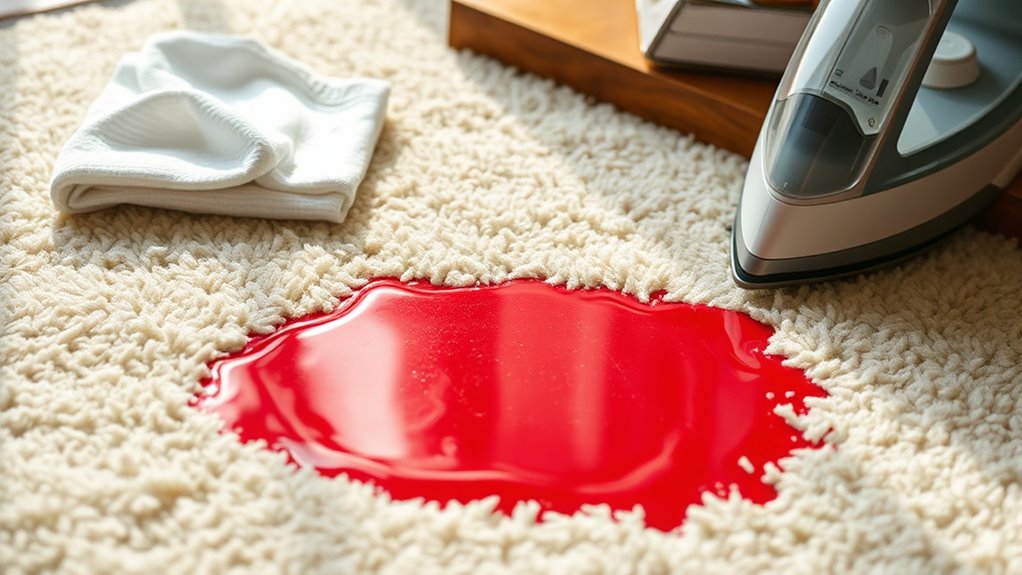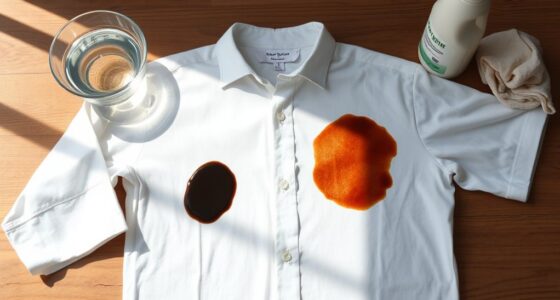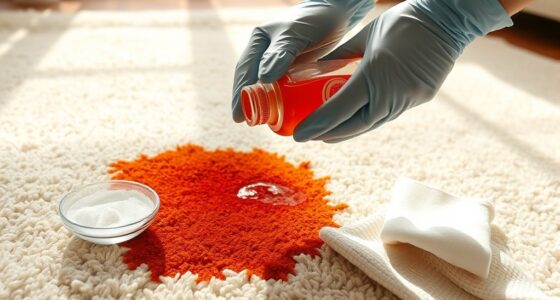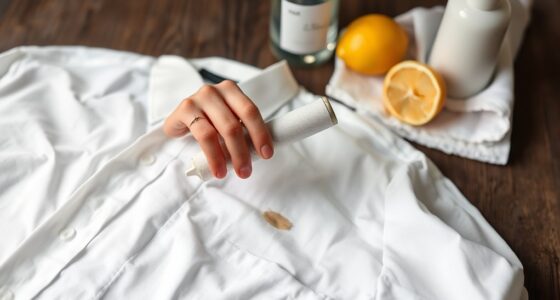To remove candle wax from carpets and upholstery, start by hardening the wax with an ice pack or ice cubes for about five minutes. Next, gently scrape off the hardened wax using a dull knife or metal spoon. For any remaining wax, place paper towels over it and use an iron on a low setting to absorb the melted wax. Finish by addressing any stains with a suitable cleaning solution. There’s more helpful tips to guarantee your fabrics stay in top shape ahead.
Key Takeaways
- Use ice packs or ice cubes to harden the wax before scraping for easier removal.
- Carefully scrape the hardened wax with a dull knife or metal spoon to avoid damaging the fibers.
- Place absorbent materials over melted wax and use an iron on a low setting to absorb it.
- Vacuum the area after scraping to collect any loose particles and residual wax.
- Test cleaning solutions on inconspicuous areas before applying them to prevent damage to carpets or upholstery.
Essential Tools for Wax Removal
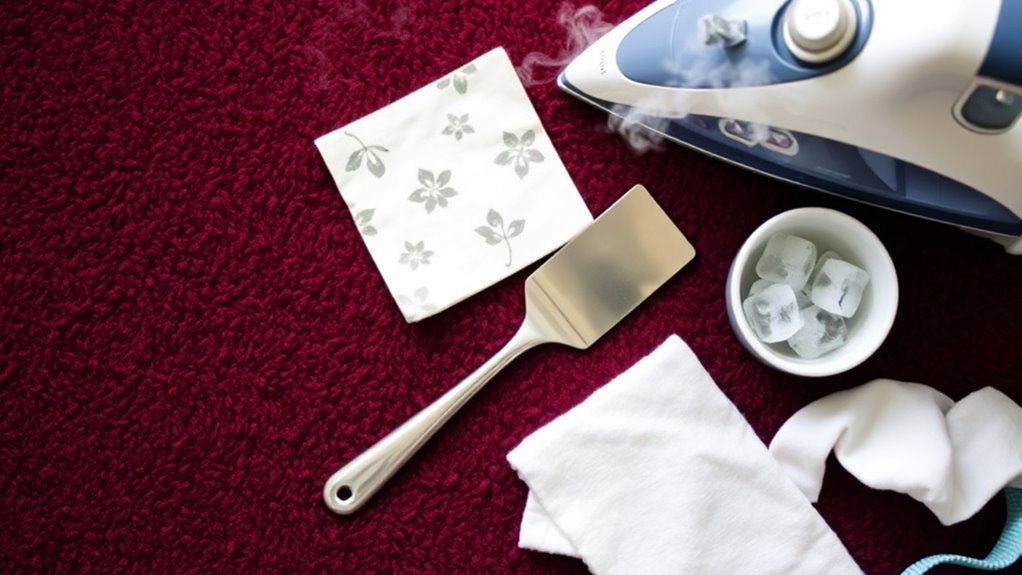
When dealing with stubborn candle wax on carpets or upholstery, having the right tools can make all the difference.
Start with an ice pack to harden the wax, preventing it from spreading. You’ll need a dull knife or a metal spoon for scraping off the hardened wax without damaging the fibers. Removing candle wax from carpet can be more effective if you start the process as soon as possible.
Use a brown paper bag or paper towels to absorb melted wax when you apply heat from a clothing iron or hairdryer. A vacuum cleaner helps clean up any residual mess.
For upholstery, a plastic scraper or credit card is handy, along with clean cloths for blotting.
Stain removers and an oxy-based carpet cleaner are essential for tackling any lingering stains post-removal.
Hardening the Wax
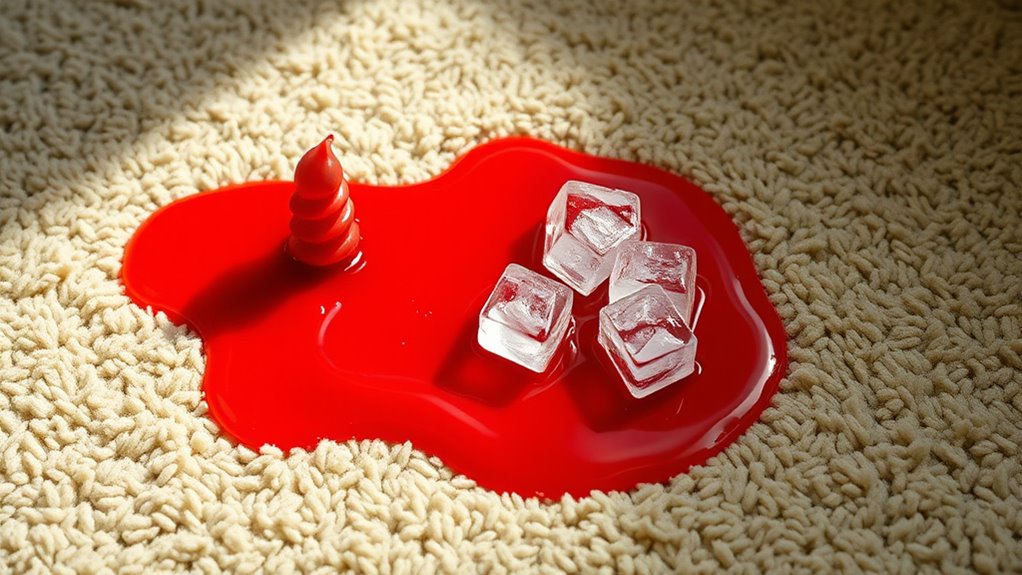
To effectively tackle candle wax spills, hardening the wax is your first step. You can speed up this process by placing ice cubes or an ice bag over the wax for about five minutes. This not only cools the wax quickly but also makes it easier to remove without smearing. Additionally, using ice cubes can harden wax spills, making them easier to lift. If you don’t have ice, compressed air works well too. Acting quickly is essential, as it prevents the wax from seeping deeper into your carpets or upholstery fibers. The freeze-drying process is similar in that it removes moisture to preserve the original quality, but in this case, it’s about maintaining the integrity of your surfaces.
Scraping Off the Wax
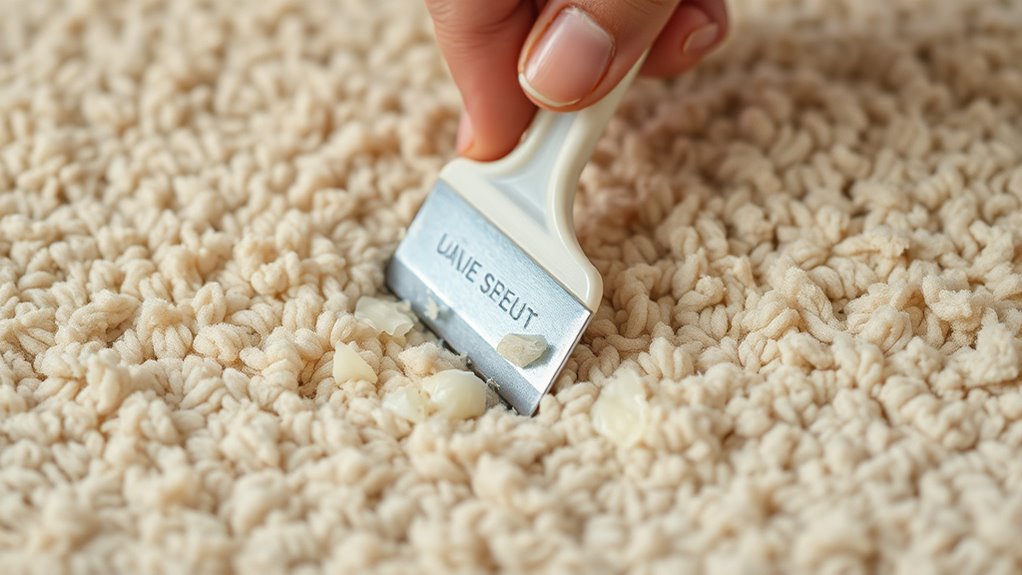
Once the wax has hardened, you can start scraping it off your carpet or upholstery. Use a blunt-edged tool, like a butter knife or a plastic scraper, to gently dislodge the wax without damaging the fibers.
Once the wax has set, carefully scrape it off using a blunt tool to protect your carpet fibers.
Be careful, especially with delicate carpets like Berber, as excessive force can lead to fraying. If you’ve chilled the wax with ice, it’ll be more brittle, making it easier to remove. However, know that this method may not completely eliminate all wax residue. After scraping, vacuum the area to collect any loose particles.
Follow up with a cleaning solution to tackle any stubborn leftover wax. This two-step process helps guarantee your surfaces are clean and wax-free. For best results, consider using professional services to ensure thorough cleaning of any remaining stains.
Applying Heat to Melt the Wax
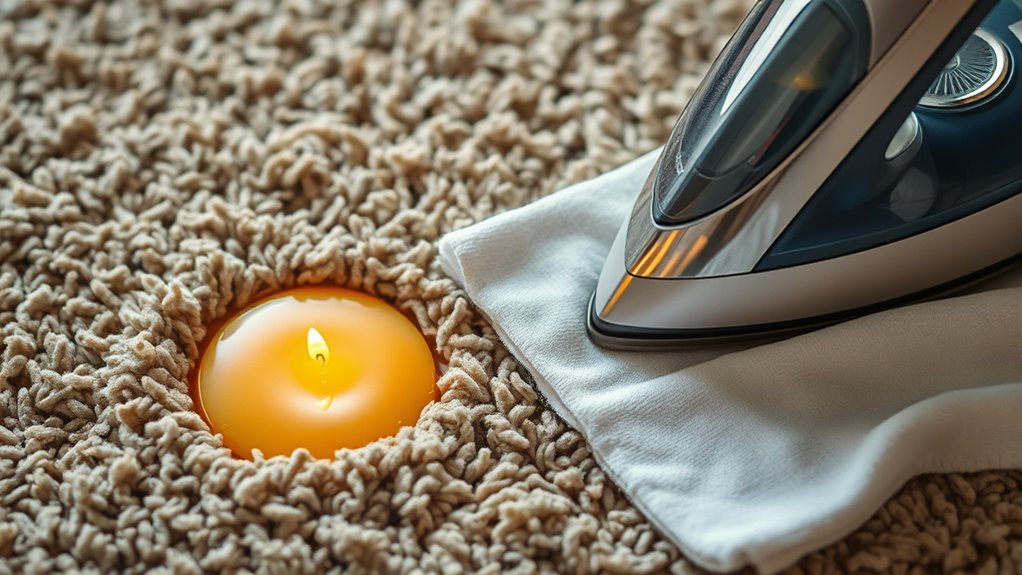
Applying heat is one of the most effective ways to remove candle wax from carpets and upholstery. Use an iron set to a suitable temperature to melt the wax without damaging the material. Place absorbent materials like paper towels or brown paper bags over the wax, guaranteeing you put a dish towel between the iron and the absorbent material to prevent scorching. Move the iron in gentle sweeping motions, distributing heat evenly. Regularly replace the absorbent materials to avoid spreading the wax. Always test a small, inconspicuous area first to confirm the heat won’t cause damage. This method is particularly effective on hard surfaces as it allows for controlled heat application, ensuring the wax melts uniformly. Keep an eye on the process, adjusting as needed until all the wax is absorbed and removed.
Removing Residual Stains
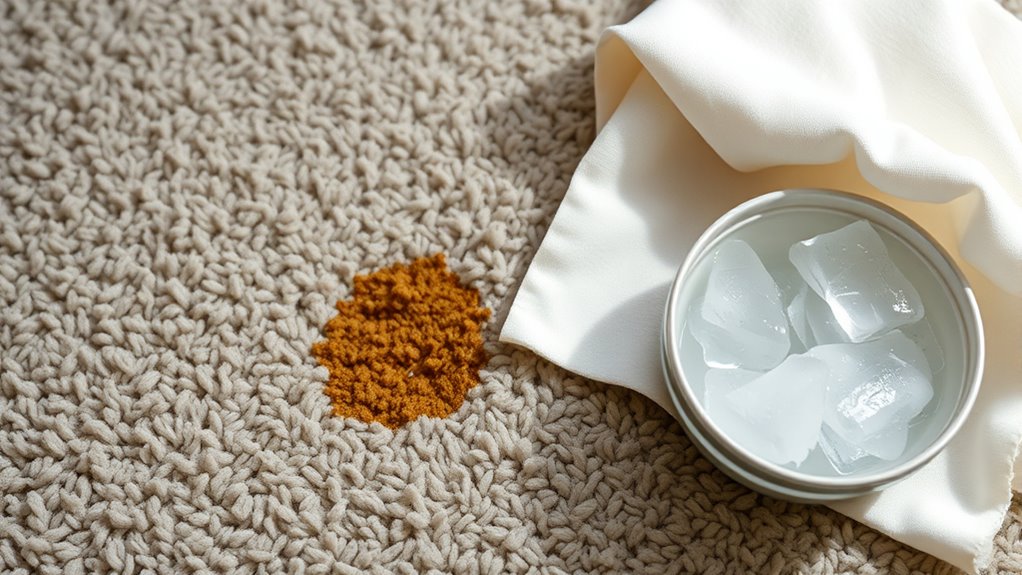
Although you’ve successfully removed the bulk of the wax, residual stains can still linger on your carpet or upholstery.
Start by evaluating the stain’s type and extent; older stains are tougher to treat. Pretest any cleaning solution on an inconspicuous area to avoid damaging the fabric.
Use a blotting technique—never rub—as this can embed the stain deeper. For stubborn residues, dampen a white cloth with hydrogen peroxide and blot the stain, allowing it to sit for an hour before re-blotting. Additionally, consider using ice cubes to solidify the wax before attempting to remove it, as this can make the process easier.
An enzyme-based detergent can effectively break down remaining wax, so apply it and let it sit for at least 15 minutes. You can also try a vinegar solution or rubbing alcohol for added effectiveness.
Preventing Future Spills

Even after successfully removing residual stains, taking steps to prevent future spills can save you from more headaches down the line.
Start by placing your candles on stable, non-flammable surfaces and always avoid edges where they might tip over. Keep the area around your candles clear to reduce the risk of accidental knocks. Additionally, ensure that your candles are placed on heat-resistant surfaces to further minimize the chances of accidents.
Shield them from drafts to guarantee even burning and minimize dripping. Limit burn time to four hours to prevent excessive wax melting.
Regularly trim wicks to maintain a controlled flame, and monitor the flame for stability. Finally, be mindful of surrounding materials and store candles in cool, dry places to prolong their lifespan.
These simple measures will help keep your space clean and safe.
Safety Considerations
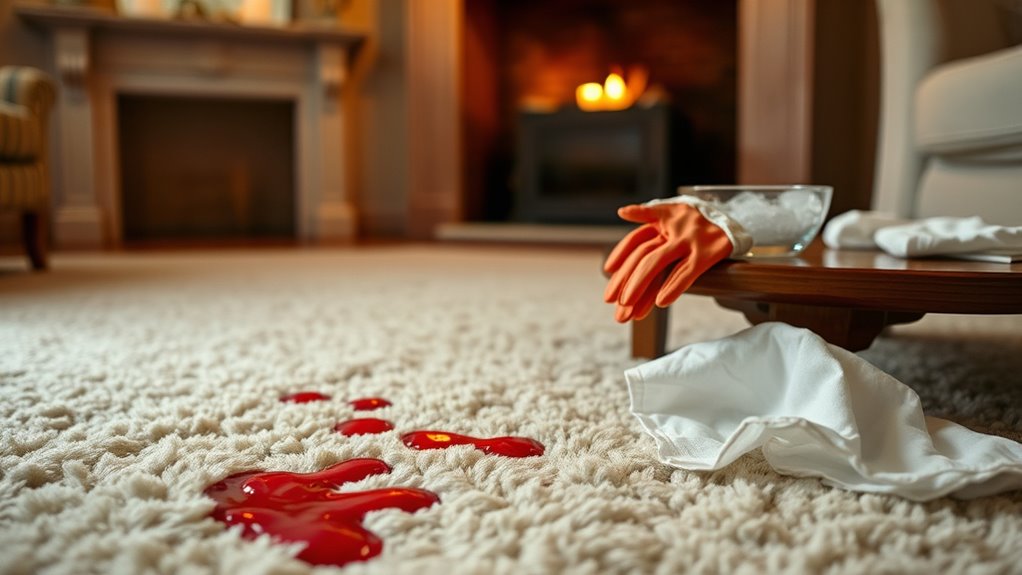
When using candles, it’s essential to understand the safety risks involved, especially since they can pose significant fire hazards. Always keep candles away from carpets and flammable materials, and never leave them unattended. If wax spills, remember that it can harden quickly, making it easier to remove, but be cautious of burns from hot wax. Use a dull knife to scrape the wax without damaging the fabric, and avoid rubbing the stain, which can push wax deeper. Protect your skin and hair from splatters, and guarantee good ventilation to prevent oxygen depletion in small spaces. Additionally, using candles can increase the risk of fire hazards in your home environment, so it’s vital to exercise caution. Incorporating rustic lighting in your home can also enhance ambiance while maintaining safety. Finally, keep a fire extinguisher nearby and know basic burn care for emergencies. Additionally, be aware that ear candling practices can lead to accidental fires due to the open flame involved. Furthermore, ensuring that candles are stored in cool, dark places can help minimize their risk of melting and becoming a hazard.
When to Seek Professional Assistance
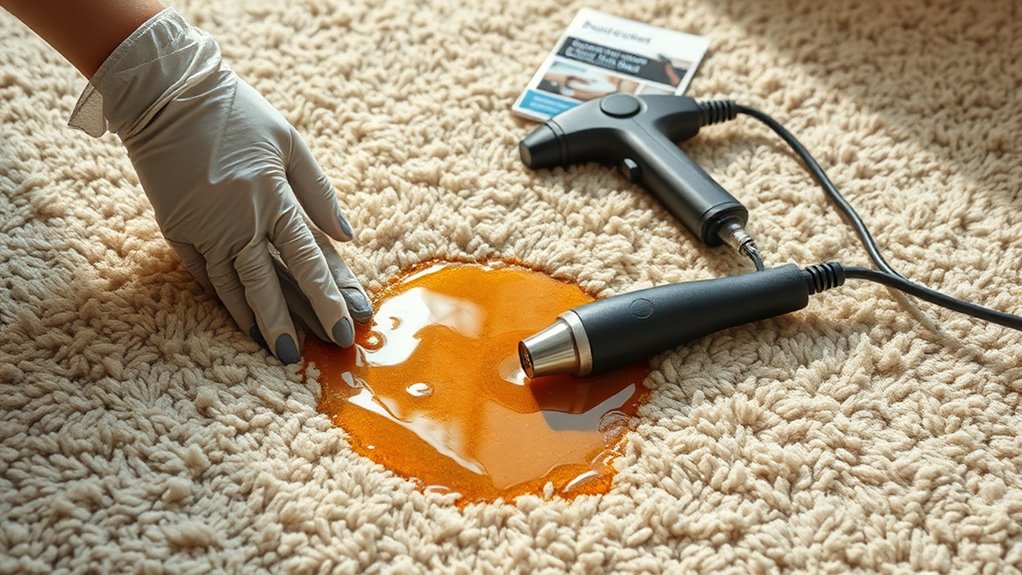
If you find yourself struggling to remove candle wax from your carpets or upholstery despite your best DIY efforts, it might be time to contemplate professional assistance.
Persistent stains that refuse to budge, especially on delicate or expensive fabrics, signal that you need expert help. Large spills can be challenging to manage without specialized equipment, and color transfer from colored wax often requires professional cleaning methods. Additionally, if wax has deeply embedded itself or left stubborn residue, it’s best to call in the pros. Understanding wax chemistry is crucial for effective removal, and professionals are trained in these methods to ensure the best results. Antique upholstery and high-value rugs also deserve careful handling to preserve their integrity.
Persistent stains on delicate fabrics indicate the necessity for expert cleaning, especially with large spills and colored wax transfers.
When in doubt, seeking professional assistance can save you time and prevent potential damage.
Tips for Regular Maintenance

Regular maintenance is key to keeping your carpets and upholstery looking their best and preventing candle wax from becoming a bigger problem. Start by vacuuming regularly to minimize dirt and debris, which makes spills easier to clean. When accidents happen, respond quickly to spills, including wax, to prevent them from setting in. Consider placing mats under candles to catch drips before they hit your carpet. If you have Berber carpets, be extra cautious when removing wax to avoid damaging the fibers. Always keep cleaning solutions handy for quick action against stains. Finally, use ice packs to harden wax before scraping it off gently with a dull knife, ensuring a cleaner and safer removal process. Additionally, freezing the wax helps to make the removal process more effective by ensuring the wax is completely hardened before scraping.
Frequently Asked Questions
Can I Use Hot Water to Remove Candle Wax From Carpets?
You shouldn’t use hot water to remove candle wax from carpets. It can actually spread the wax, making the situation worse.
Instead, try using cold methods, like freezing the wax with an ice pack, which hardens it for easier scraping.
After that, you can gently scrape it off and use an iron on low heat (without steam) to melt any remaining wax, absorbing it with a paper towel.
This method works much better!
Is There a Specific Type of Carpet Safe for Wax Removal?
When it comes to carpet safety during wax removal, synthetic fibers are generally your best bet. They’re less absorbent, making cleanup easier.
Plush carpets can often handle wax removal well too, but be cautious, as their soft piles may trap residue.
Berber carpets, with their tight loops, can be trickier; avoid sharp tools to prevent damage.
Always test any cleaning method on a small area first to guarantee it won’t harm your carpet.
How Long Should I Wait Before Using the Carpet After Cleaning?
You might think you can waltz right onto your freshly cleaned carpet, but hold your horses!
You should wait until it’s completely dry before stepping on it. Depending on your cleaning method, this could take anywhere from 6 hours to a couple of days.
Factors like ventilation and carpet type play a big role, so be patient.
Give it time, and your carpet will thank you for avoiding stains and damage!
Will Candle Wax Permanently Stain My Carpet or Upholstery?
Yes, candle wax can permanently stain your carpet or upholstery if not treated quickly.
The dye in colored candles can penetrate deeply, making removal difficult over time. If you let the wax sit, it hardens and can cause more damage.
Always act fast, and remember that different materials may react differently to cleaning methods. If unsure, it’s best to consult a professional to avoid worsening the stain or damaging your fabrics.
What if the Wax Is From a Colored Candle?
“Where there’s a will, there’s a way.”
If the wax is from a colored candle, you’ll need to take extra steps to tackle the dye. First, freeze the wax with ice to harden it, then scrape off as much as you can.
For any lingering color, dab the stain with a cloth soaked in rubbing alcohol. Finish by cleaning the area with a mild detergent solution to guarantee it’s completely clear.
Conclusion
Removing candle wax from carpets and upholstery can feel like untangling a knot, but with the right tools and techniques, you can restore your fabrics to their former glory. By hardening the wax, scraping it off, and carefully applying heat, you can tackle even the toughest stains. Remember to take preventative measures for the future and don’t hesitate to call in professionals if needed. Keep your space looking fresh and inviting with regular maintenance!
